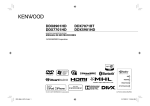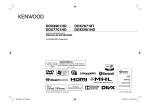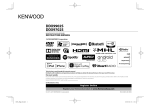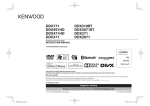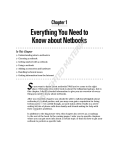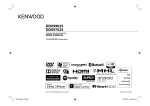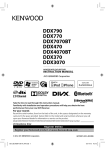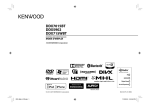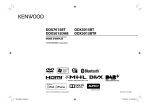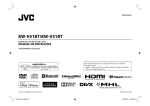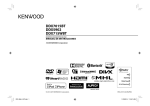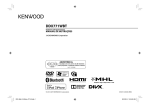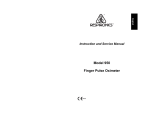Download Kenwood DDX5901HD Operation Manual
Transcript
DDX8901HD DDX7701HD DDX7071BT DDX5901HD MONITOR WITH DVD RECEIVER INSTRUCTION MANUAL Take the time to read through this instruction manual. Familiarity with installation and operation procedures will help you obtain the best performance from your new DVD-receiver. For your records Record the serial number, found on the back of the unit, in the spaces designated on the warranty card, and in the space provided below. Refer to the model and serial numbers whenever you call upon your Kenwood dealer for information or service on the product. Model DDX8901HD/DDX7701HD/DDX7071BT/DDX5901HD Serial number US Residents Only Register Online Register your Kenwood product at www.Kenwoodusa.com © 2014 JVC KENWOOD Corporation DDX_Mid_K.indb 1 LVT2510-001A (KN/RN) 2014/01/23 15:45 CONTENTS BEFORE USE............................................................ 2 How to reset your unit.................................................... 3 INITIAL SETTINGS .................................................. 4 BASICS .................................................................... 6 Component names and functions ............................. 6 Common operations ....................................................... 7 Common screen operations......................................... 8 Selecting the playback source..................................... 9 DISCS .................................................................... 10 USB........................................................................ 15 iPod/iPhone ......................................................... 16 APPs ...................................................................... 19 Pandora® (Only for DDX8901HD/DDX7701HD/ DDX5901HD) ........................................................ 20 iHeartRADIO (Only for DDX8901HD/DDX7701HD/ DDX5901HD) ........................................................ 22 TUNER (Only for DDX7071BT) ............................ 24 HD Radio™ tuner (Only for DDX8901HD/ DDX7701HD/DDX5901HD) ................................. 26 SiriusXM® RADIO (Only for DDX8901HD/ DDX7701HD/DDX5901HD) ................................. 29 OTHER EXTERNAL COMPONENTS ...................... 34 Using external audio/video players—AV-IN ........34 Using a rear view camera ............................................34 BEFORE USE Using a smartphone—HDMI/MHL...........................35 Using an external component via ADS adapter—OEM Features (Only for DDX8901HD/ DDX7701HD/DDX5901HD) ........................................35 BLUETOOTH ......................................................... 36 SETTINGS .............................................................. 44 Settings for using applications of the iPod/ iPhone/Android ..............................................................44 Sound adjustment .........................................................45 Adjustment for video playback.................................47 Changing display design .............................................49 Customizing the <TOP MENU> screen ..................50 Customizing the system settings .............................50 Setting menu items .......................................................52 REMOTE CONTROLLER ........................................ 55 CONNECTION/INSTALLATION ............................ 60 REFERENCES ......................................................... 66 Maintenance ....................................................................66 More information ...........................................................66 Error message list ...........................................................70 Troubleshooting .............................................................71 Notice/Caution on using Bluetooth devices (Only for DDX8901HD/DDX7701HD/DDX5901HD).......73 Specifications...................................................................73 V WARNINGS: (To prevent accidents and damage) • DO NOT install any unit or wire any cable in a location where; – it may obstruct the steering wheel and gearshift lever operations. – it may obstruct the operation of safety devices such as air bags. – it may obstruct visibility. • DO NOT operate the unit while driving. If you need to operate the unit while driving, be sure to look around carefully. • The driver must not watch the monitor while driving. For DDX7071BT: The marking of products using lasers The label is attached to the chassis/case and says that the component uses laser beams that have been classified as Class 1. It means that the unit is utilizing laser beams that are of a weaker class. There is no danger of hazardous radiation outside the unit. How to read this manual: • Illustrations of DDX8901HD are mainly used for explanation. The displays and panels shown in this manual are examples used to provide clear explanations of the operations. For this reason, they may be different from the actual displays or panels. • This manual mainly explains operations using the buttons on the monitor panel and touch panel. For operations using the remote controller (RC-DV340: supplied only for DDX7071BT), see page 55. • < > indicates the various screens/menus/operations/settings that appear on the touch panel. • [ ] indicates the buttons on the touch panel. • Indication language: English indications are used for the purpose of explanation. You can select the indication language from the <Setup> menu. (Page 54) 2 DDX_Mid_K.indb 2 2014/01/23 15:45 BEFORE USE For DDX8901HD/DDX7701HD/DDX5901HD: V CAUTION Use of controls or adjustments or performance of procedures other than those specified herein may result in hazardous radiation exposure. In compliance with Federal Regulations, the following are reproductions of labels on, or inside the product relating to laser product safety. JVC KENWOOD Corporation 2967-3, ISHIKAWA-MACHI, HACHIOJI-SHI, TOKYO, JAPAN THIS PRODUCT COMPLIES WITH DHHS RULES 21CFR SUBCHAPTER J IN EFFECT AT DATE OF MANUFACTURE. Location : Top plate For DDX8901HD/DDX7701HD/DDX5901HD: FCC WARNING This equipment may generate or use radio frequency energy. Changes or modifications to this equipment may cause harmful interference unless the modifications are expressly approved in the instruction manual. The user could lose the authority to operate this equipment if an unauthorized change or modification is made. FCC NOTE This equipment has been tested and found to comply with the limits for a Class B digital device, pursuant to Part 15 of the FCC Rules. These limits are designed to provide reasonable protection against harmful interference in a residential installation. This equipment may cause harmful interference to radio communications, if it is not installed and used in accordance with the instructions. However, there is no guarantee that interference will not occur in a particular installation. If this equipment does cause harmful interference to radio or television reception, which can be determined by turning the equipment off and on, the user is encouraged to try to correct the interference by one or more of the following measures: • Reorient or relocate the receiving antenna. • Increase the separation between the equipment and receiver. • Connect the equipment to an outlet on a circuit different from that to which the receiver is connected. • Consult the dealer or an experienced radio/TV technician for help. V Cautions on the monitor: • The monitor built into this unit has been produced with high precision, but it may have some ineffective dots. This is inevitable and is not considered defective. • Do not expose the monitor to direct sunlight. • Do not operate the touch panel using a ball-point pen or similar tool with a sharp tip. Touch the buttons on the touch panel with your finger directly (if you are wearing a glove, take it off). • When the temperature is very cold or very hot... – Chemical changes occur inside, causing malfunction. – Pictures may not appear clearly or may move slowly. Pictures may not be synchronized with the sound or picture quality may decline in such environments. For safety... • Do not raise the volume level too much, as this will make driving dangerous by blocking outside sounds, and may cause hearing loss. • Stop the car before performing any complicated operations. Temperature inside the car... If you have parked the car for a long time in hot or cold weather, wait until the temperature in the car becomes normal before operating the unit. ❏ How to reset your unit DDX8901HD/DDX7701HD/DDX7071BT DDX5901HD If the unit fails to operate properly, press the Reset button. The unit returns to factory settings when the Reset button is pressed (except the registered Bluetooth devices). ENGLISH DDX_Mid_K.indb 3 3 2014/01/23 15:45 INITIAL SETTINGS Initials etup 2 Finish the procedure. When you power on the unit for the first time or reset the unit, the initial setting screen appears. • You can also change the settings on the <Setup> screen. (Page 52) 1 Activating the security function You can activate the security function to protect your receiver system against theft. 1 Display the <TOP MENU> screen. The <TOP MENU> screen is displayed. On the source control screen: * Onlyfor D DX8901HD/DDX7701HD/DDX7071BT. * 2 Display the <System> setting screen. <Language> Select the text language used for (Page 54) on-screen information. • Set <GUI Language> to display the operation buttons and menu items in the selected language ([Local]: initially selected) or English ([English]). <Angle>* Adjust the panel angle. (Page 7) Select [ON] when connecting <R-CAM the rear view camera. Interrupt> (Page 53) Select the color of the buttons <Panel on the monitor panel. Color> (Page 49) • Press [K] repeatedly to change the page on the <System> menu screen. 4 DDX_Mid_K.indb 4 2014/01/23 15:45 INITIAL SETTINGS 3 Clock settings 4 Set the clock time. 1 Display the <TOP MENU> screen. On the source control screen: The security indicator on the monitor panel flashes when the vehicle ignition is off. 2 Display the <Setup> screen. To deactivate the security function: Select [OFF] for <SI>. 3 Display the <Clock> screen. <Radio Data Synchronizes the clock time with System> FM RBDS. <OFF> Sets the clock manually. (See below.) When selecting <OFF>: Adjust the hour (1), then adjust the minute (2). • Press [Reset] to set the minute to “00”. 5 Finish the procedure. ENGLISH DDX_Mid_K.indb 5 5 2014/01/23 15:45 BASICS Component names and functions DDX8901HD/DDX7701HD/DDX7071BT 1 Monitor panel* 2 Screen (touch panel) 3 Reset button/Power indicator/Security indicator • Resets the unit. (Page 3) • Lights up while the unit is turned on. • Flashes when the security function is activated. (Page 4) 4 Volume K/J button Adjusts the audio volume. (Page 7) 5 AV/AV OUT button • Displays the current source screen. (Press) • The function of the button when held varies depending on the <AV Key Long Press> setting. (Page 54) 6 AUD/R-CAM button • Displays the <Equalizer> screen. (Press) (Page 45) • The function of the button when held varies depending on the <AUD Key Long Press> setting. (Page 54) 7 MENU button • Displays the <TOP MENU> screen. (Press) (Page 8) • Turns off the power. (Hold) (Page 7) • Turns on the power. (Press) (Page 7) 8 TEL/VOICE button • Displays the phone control screen. (Press) (Page 40) • Activates voice dialing. (Hold) (Page 41) 9 M (Eject) button • Ejects the disc. (Tilts the monitor panel fully.) • Opens/closes the monitor panel. 4 5 DDX5901HD 6 7 1 Reset button/Power indicator/Security indicator • Resets the unit. (Page 3) • Lights up while the unit is turned on. • Flashes when the security function is activated. (Page 4) 2 M (Eject) button Ejects the disc. 3 Loading slot 8 9 MENU button • Displays the <TOP MENU> screen. (Press) (Page 8) • Turns off the power. (Hold) (Page 7) • Turns on the power. (Press) (Page 7) AV/AV OUT button • Displays the current source screen. (Press) • The function of the button when held varies depending on the <AV Key Long Press> setting. (Page 54) Volume/ATT/AUD knob • Attenuates the sound. (Press) (Page 7) • Adjusts the audio volume. (Turn) (Page 7) • Displays the <Equalizer> screen. (Hold) (Page 45) TEL/VOICE button • Displays the phone control screen. (Press) (Page 40) • The function of the button when held varies depending on the <TEL Key Long Press> setting. (Page 54) Monitor panel* Screen (touch panel) * You can change the color of the buttons on the monitor panel. (Page 49) V Caution on the volume setting: Digital devices produce very little noise compared with other sources. Lower the volume before playing these digital sources to avoid damaging the speakers by sudden increase of the output level. 6 DDX_Mid_K.indb 6 2014/01/23 15:45 BASICS To attenuate the sound (only for DDX5901HD) Common operations 2 Select an angle (0 – 6). ❏ Turning on the power DDX8901HD DDX7701HD DDX7071BT DDX5901HD The ATT indicator lights up. To cancel the attenuation: Press the same button again. ❏ Turning off the power DDX8901HD DDX7701HD DDX7071BT DDX5901HD (Hold) • To set the current position as the power off position, select [Memory]. ❏ Adjusting the panel angle (only for DDX8901HD/DDX7701HD/DDX7071BT) ❏ Putting the unit in standby 1 Display the <Angle Adjust> screen. 1 Display all <TOP MENU> items. On the <TOP MENU> screen: On the <TOP MENU> screen: • Press [K] repeatedly to change the page on the <Display> menu screen. (Hold) 2 ❏ Adjusting the volume To adjust the volume (00 to 35) DDX8901HD DDX7701HD DDX7071BT Press J to increase, and press K to decrease. • Holding the button increases/decreases the volume continuously. DDX5901HD Turn to the right to increase, and turn to the left to decrease. ENGLISH DDX_Mid_K.indb 7 7 2014/01/23 15:45 BASICS ❏ Turning off the screen DDX8901HD DDX7701HD DDX7071BT*1 (Hold) DDX5901HD*2 (Hold) To turn on the screen: Press MENU on the monitor panel, or touch the display. *1 This operation works only when <AUD Key Long Press> is set to [V-OFF]. (Page 54) *2 This operation works only when <TEL Key Long Press> is set to [V-OFF]. (Page 54) Common screen operations ❏ Common screen descriptions You can display other screens any time to change the source, show the information, or change the settings, etc. Source control screen Performs source playback operations. • The operation buttons vary depending on the selected source. 1 Common operation buttons: 1 Displays other operation buttons. • Disabled when there are no other buttons. 2 Switches between the normal source control screen and easy control screen. (See below.) 3 Displays the <TOP MENU> screen. (See the right column.) • Pressing MENU on the monitor panel also displays the <TOP MENU> screen. Easy control screen Pressing [ ] switches between the normal source control screen and easy control screen. The easy control screen allows you to control the source easily with simple buttons. • The displayed buttons vary depending on the selected source. <TOP MENU> screen Displays the source control screen and settings screen. 1 3 Common operating buttons: 1 Changes the playback source. (Page 9) • Press [ALL SRC] to display all <TOP MENU> items. (Page 9) • You can arrange the items to display on the <TOP MENU> screen. (Page 50) 2 Displays the phone control screen. (Page 40) 3 Displays the <Setup> screen. (See below.) <Setup> screen Changes the detailed settings. (Page 52) 1 3 2 2 3 2 4 Common operating buttons: 1 Selects the menu category. 2 Displays the <TOP MENU> screen. 3 Changes the page. 4 Returns to the previous screen. 8 DDX_Mid_K.indb 8 2014/01/23 15:45 BASICS ❏ Touch screen operations Selecting the playback source 1 3 On the <TOP MENU> screen: 4 2 [OEM Features]*1 Switches to the source connected via ADS adapter. (Page 35) [AV-IN1][AV-IN2] Switches to an external component connected to the AVIN1 or iPod/AV-IN2 input terminal. (Page 34) *1 Only for DDX8901HD/DDX7701HD/DDX5901HD. *2 Only for DDX7071BT. 1 Displays the video control menu while playing a video. 2 Displays the source control screen while playing a video. • The operation buttons disappear when the screen is touched or when no operation is done for about 5 seconds. 3 Goes to the previous chapter/track.* 4 Goes to the next chapter/track.* * Not available for video from an external component. • You can change the items (other than [SETUP]) to display on the <TOP MENU> screen. (Page 50) [DISC] Plays a disc. (Page 10) [HD Radio]*1 Switches to the HD Radio broadcast. (Page 26) [TUNER]*2 Switches to the conventional radio broadcast. (Page 24) [iPod] Plays an iPod/iPhone. (Page 16) [USB] Plays files on a USB device. (Page 15) [HDMI/MHL] Plays a device connected to the HDMI/MHL input terminal. (Page 35) [SiriusXM]*1 Switches to the SiriusXM® radio broadcast. (Page 29) [PANDORA]*1 Switches to the Pandora broadcast. (Page 20) [iHeartRadio]*1 Switches to the iHeartRADIO broadcast. (Page 22) [Bluetooth] Plays a Bluetooth audio player. (Page 42) [APPs] Switches to the screen of App from the connected iPod touch/ iPhone. (Page 19) [TEL] Displays the phone control screen. (Page 40) ❏ To display all sources and items on the <TOP MENU> screen • You can change the page to display more items by pressing [J]/[K]. ENGLISH DDX_Mid_K.indb 9 9 2014/01/23 15:45 DISCS Playing a disc • If a disc does not have a disc menu, all tracks on it will be played repeatedly until you change the source or eject the disc. • For playable disc types/file types, see page 67. ❏ Ejecting a disc DDX8901HD DDX7701HD DDX7071BT DDX5901HD ❏ Indications and buttons on the source control screen For DVD/DVD-VR/VCD/DivX/MPEG1/MPEG2 1 2 3 ❏ Inserting a disc Insert a disc with the label side facing up. DDX8901HD/DDX7701HD/DDX7071BT • When removing a disc, pull it horizontally. • You can eject a disc when playing another AV source. • If the ejected disc is not removed within 60 seconds, the disc is automatically inserted again into the loading slot to protect it from dust. Closing the monitor panel (only for DX8901HD/ DDX7701HD/DDX7071BT) After removing the disc, press M on the monitor panel. The monitor panel closes. DDX5901HD Playback operations The source changes to “DISC” and playback starts. • The IN indicator lights up while a disc is inserted. When the operation buttons are not displayed on the screen, touch the area shown on the illustration. • To change settings for video playback, see page 47. 4 5 6 Playback information 1 Media type 2 Current playback item information • DVD Video: Title no./Chapter no. • DVD-VR: Program no. (or Playlist no.)/Chapter no.* • DivX/MPEG1/MPEG2: Folder no./Track no. • VCD: Scene no. (with PBC) or Track no. (without PBC) 3 Playing time 4 Playback mode (Page 13) 5 File type (for DivX/MPEG1/MPEG2) 6 IN indicator * To display the Original Program/Playlist screen, see page 11. • If “ ” appears on the screen, the unit cannot accept the operation you have tried to do. – In some cases, without showing “ ,” operations will not be accepted. • When playing back a multi-channel encoded disc, the multi-channel signals are downmixed to stereo. 10 DDX_Mid_K.indb 10 2014/01/23 15:45 DISCS Operation buttons Displays the easy control screen. [ ] (Page 8) Displays the folder/track list. [ ]*1 (Page 12) • Reverse/forward search during [O] [N] playback.*2 • Selects a chapter/track. (Press) [S] [T] • Reverse/forward search.*2 (Hold) Starts/pauses playback. [IW] Stops playback. [o] [ ] Displays other operation buttons. • Disabled when there are no other buttons. [MODE] Changes the settings for disc playback on the <DISC Mode> screen. (Page 14) [ ][ ]*3 Selects playback mode. (Page 13) [Playlist]*4 Displays an Original Program/Playlist screen. Plays in frame-by-frame. [ ] [ ]*5 Selects a folder. [ ] [ ]*1 Activates or deactivates the VCD PBC [PBC]*6 (Playback Control) function. [MENU] Displays the <TOP MENU> screen. *1 *2 *3 *4 *5 *6 Does not appear for DVD/DVD-VR/VCD. Search speed varies depending on the type of disc or file. Does not appear for DVD/DVD-VR. Appears only for DVD-VR. Appears only for DVD/DVD-VR. Appears only for VCD. ForC D/MP3/WMA/AAC 1 2 3 4 5 6 7 8 Playback information 1 Media type 2 Track/file information • Pressing [<] scrolls the text if not all of the text is shown. 3 Current playback item information • MP3/WMA/AAC: Folder no./Track no. • CD: Track no. 4 Playback status 5 Playing time 6 Playback mode (Page 13) 7 File type 8 IN indicator Operation buttons Displays the easy control screen. [ ] (Page 8) Displays the folder/track list. [ ]*1 (Page 12) Selects a track. [S] [T] Reverse/forward search.*2 [O] [N] Starts/pauses playback. [IW] [ ] Displays other operation buttons. • Disabled when there are no other buttons. [MODE] Changes the settings for disc playback on the <DISC Mode> screen. (Page 14) [ ] [ ]*1 Selects a folder. Selects playback mode. (Page 13) [ ][ ] Stops playback. [o] [MENU] Displays the <TOP MENU> screen. *1 Does not appear for CDs. *2 Search speed varies depending on the type of disc or file. ENGLISH DDX_Mid_K.indb 11 11 2014/01/23 15:45 DISCS ❏ Selecting a folder/track on the list ❏ Video menu operations 1 You can display the video menu screen during video playback. • Available items on the screen differ depending on the types of the loaded disc and playback files. • The operation buttons disappear when the screen is touched or when no operation is done for about 5 seconds. 2 Select the folder (1), then the item in the selected folder (2). • Repeat the procedure until you select the desired track. • You can change the page to display more items by pressing [J]/[K]. • Press [ ] to open the folder containing the current track. • Press [ ] to return to the root folder. • Press [ ] to return to the upper layer. [ZOOM]* * * Displays the picture size selecting screen. (Page 48) [Aspect] Selects the aspect ratio. (Page 48) [PictureAdjust] Displays the picture adjustment screen. (Page 47) [Audio]* Selects the audio type (or channel for DVD-VR). [Subtitle]* Selects the subtitle type. [Angle]* Selects the view angle. [MENU]* Displays the disc menu. [T MENU]* Displays the disc menu (DVD). [CUR]* Displays the menu/scene selecting screen. • [J] [K] [H] [I]: Selects an item. • [Enter]: Confirms the selection. • [Return]: Returns to the previous screen. [Highlight]* Switches to the direct disc menu mode. Touch the target item to select. • To restore the screen, press AV on the monitor panel. * May not appear depending on the media/file etc. 12 DDX_Mid_K.indb 12 2014/01/23 15:45 DISCS For VCD 1 • To select a track directly, press [Direct] to display the direct selecting buttons, then... 2 – When you enter a wrong number, press [CLR] to delete the last entry. [ZOOM] Displays the picture size selecting screen. (Page 48) [Aspect] Selects the aspect ratio. (Page 48) [PictureAdjust] Displays the picture adjustment screen. (Page 47) [Audio] Selects the audio channel (ST: stereo, LL: left, RR: right). [Return] Displays the previous screen or menu. [Direct] Displays/hides the direct selecting buttons. (See the right column.) ❏ Selecting playback mode [ ] [ ] Selects Repeat playback mode. Selects Random playback mode. • For DVD/DVD-VR: Repeat play is available. For VCD (without PBC)/CD/DivX/MPEG1/MPEG2/ MP3/WMA/AAC: Repeat and Random play are available. – You cannot activate the repeat mode and the random mode at the same time. • Each time you press the button, the playback mode changes. (The corresponding indicator lights up.) – Available items differ depending on the types of loaded disc and playback file. C-REP T-REP REP FO-REP FO-RDM RDM Repeats current chapter. Repeats current title/program. Repeats current track. Repeats all tracks of the current folder. Randomly plays all tracks of the current folder, then tracks of the next folders. Randomly plays all tracks. To cancel Repeat/Random playback: Press the button repeatedly until the indicator disappears. ENGLISH DDX_Mid_K.indb 13 13 2014/01/23 15:45 DISCS Settings for disc playback <Screen Ratio>* Select the monitor type to watch a wide screen picture on the external monitor. 16:9 (Initial) 4:3 LB 4:3 PS <Parental Level>* <CD Read> Set the parental level. (See below.) Select the files to play back a disc containing music files. You cannot change the setting when a disc is inserted. • 1 (initial): Automatically distinguishes between audio file discs and music CDs. • 2: Forces to play as a music CD. No sound can be heard if an audio file disc is played. 2 Enter the 4-digit parental pass code (1), and press [Enter] (2). • The items available on the <DISC Mode> screen are different depending on the discs/files played back. ❏ Setting items <Menu Select the initial disc menu language. Language>* (Initial: English) (Page 69) <Audio Language>* <Subtitle Language>* <Dynamic Range Control>* <Angle Mark> Select the initial audio language. (Initial: Original) (Page 69) Select the initial subtitle language or turn subtitles off (Off). (Page 69) • Initial for DDX8901HD/ DDX7701HD/DDX5901HD: Off, for DDX7071BT: English You can change the dynamic range while playing Dolby Digital software. • Wide: Select this to enjoy a powerful sound at a low volume level with its full dynamic range. • Normal: Select this to reduce the dynamic range a little. • Dialog (initial): Select this to reproduce movie dialog more clearly. Select whether to display the angle mark. • ON (initial): Select this to display the angle mark. • OFF: Select this to hide the angle mark. * You can change these settings only while playback is stopped. • To clear the entry, press [Clear]. • To cancel setting the code, press [Cancel]. 3 Adjust the parental level (OFF, Level 1 to Level 8). To deactivate the parental lock: Select [OFF] for <Parental Level>. Setting the parental lock The parental lock cannot be set during DVD playback. 1 Display the <Parental Pass> screen. On the <DISC Mode> screen: • Press [K] repeatedly to change the page on the <DISC Mode> screen. 14 DDX_Mid_K.indb 14 2014/01/23 15:45 USB Connecting a USB device You can connect a USB mass storage class device such as a USB memory, Digital Audio Player etc. to the unit. • For details about connecting USB devices, see page 63. • You cannot connect a computer or portable HDD to the USB input terminal. • For playable file types and notes on using USB devices, see page 68. When a USB device is connected... The source changes to “USB” and playback starts. • All tracks in the USB device will be played repeatedly until you change the source. To disconnect the USB device safely: Press [M], then disconnect the USB device after “No Device” appears. Playback operations When the operation buttons are not displayed on the screen, touch the area shown on the illustration. • To change settings for video playback, see page 47. ❏ Indications and buttons on the source control screen 1 2 3 4 5 6 7 Playback information 1 Track/file information (for MP3/WMA/WAV/AAC/ FLAC) • Pressing [<] scrolls the text if not all of the text is shown. 2 Current playback item information • MPEG1/MPEG2/H.264/WMV: Folder no., Track no., etc. • MP3/WMA/WAV/AAC/FLAC: Folder no., Track no., etc. • JPEG/BMP/PNG: Folder no./File no. 3 Playback status 4 Playing time 5 Jacket picture (Shown while playing if the file has tag data that includes the jacket picture) 6 Playback mode (See the right column.) 7 File type Operation buttons Displays the easy control screen. [ ] (Page 8) Displays the list selection screen. [ ] (Page 16) [S] [T] Selects a track. [O] [N] Reverse/forward search.*1 Starts/pauses playback. [IW] [ ] Displays other operation buttons. • Disabled when there are no other buttons. [MODE] Changes the picture display time setting on the <USB Mode> screen. (Page 16) [ ][ ] Selects a folder. Selects repeat playback mode.*2 *3 ] [ • REP: Repeats the current track/file. • FO-REP: Repeats all tracks/files in the current folder or specified category. Selects random playback mode.*2 *3 [ ] • RDM: – When selecting the track/file from the folder, randomly plays all tracks/files of the current folder, then the tracks/files of the next folder. – When selecting the track/file from the category, randomly plays all tracks/files of the specified category. Disconnects the USB device safely. [M] [MENU] Displays the <TOP MENU> screen. *1 Search speed varies depending on the file type. *2 To cancel random or repeat mode, press the button repeatedly until the indicator disappears. *3 You cannot activate the repeat mode and the random mode at the same time. ENGLISH DDX_Mid_K.indb 15 15 2014/01/23 15:45 iPod/iPhone USB ❏ Setting <Picture Display Time> Set the interval between slides during slide-shows of the picture files. • On the <Category List>/<Folder List>: You can switch the file type to list: Press [ ] to list audio files, [ ] to list video files, or [ ] to list still picture files. • On the <Category List>/<Link Search>: To list the items in alphabetical order, press [A-Z], then select the first character. From <Category List>: Select the category (1), then the item in the selected category (2). ❏ Selecting a track in a list 1 2 Select the list. 3 From <Link Search>: Select the tag type to display the list of contents containing the same tag as the track/file currently played back (1), then the item (2). Select the track. 3 Select the track. • You can change the page to display more items by pressing [J]/[K]. • Press [ ] to return to the root folder. • Press [ ] to return to the upper layer. • Press [ ] to open the folder containing the current track. • If you want to play all tracks in the folder, press [I] on the right of the desired folder. From <Folder List>: Select the folder (1), then the item in the selected folder (2). Preparation ❏ Connecting iPod/iPhone • For details about connecting iPod/iPhone, see page 63. • For playable iPod/iPhone types, see page 69. Connect your iPod/iPhone according to your purpose or the type of the iPod/iPhone. Wired connection • To listen to music: – For iPod/iPhone except for iPhone 5/iPod touch (5th Generation)/iPod nano (7th Generation), use USB Audio cable for iPod/iPhone— KCA-iP102 (optional accessory) – For iPhone 5/iPod touch (5th Generation)/ iPod nano (7th Generation), use USB 2.0 cable (accessory of the iPod/iPhone) • To watch video and listen to music: – For iPod/iPhone except for iPhone 5/iPod touch (5th Generation)/iPod nano (7th Generation), use USB Audio and Video cable for iPod/ iPhone—KCA-iP202 (optional accessory) – For iPhone 5/iPod touch (5th Generation)/iPod nano (7th Generation), use the HDMI cable KCA-HD100 (optional accessory) and USB 2.0 cable (accessory of the iPod/iPhone) through Lightning-Digital AV adapter (accessory of the iPod/iPhone) 16 DDX_Mid_K.indb 16 2014/01/23 15:45 iPod/iPhone Bluetooth connection Pair the iPod/iPhone through Bluetooth. (Page 36) • For iPhone 5/iPod touch (5th Generation)/iPod nano (7th Generation): To watch the video, connect your iPod/iPhone to HDMI/MHL input terminal using KCA-HD100 (optional accessory). (Page 63) • For iPod/iPhone except for iPhone 5/iPod touch (5th Generation)/iPod nano (7th Generation): You cannot watch the video with Bluetooth connection. • If [Enter] for <iPod Setup> cannot be selected, put the unit in standby. (Page 7) 2 • When selecting <USB + AV-IN> or <USB 1 Wire>, go to step 5. 4 When selecting <HDMI + Bluetooth> or • If you do not need to change the setting, press [OK] to exit from the setup screen. 3 Select the connection method (1), then <Bluetooth> as the connection method, the device selection screen appears. Search for the available iPod/iPhone devices (1), then select the target device from the list (2). press [Next] (2). ❏ Selecting the iPod/iPhone device to play and connection method • You can change the page to display more items by pressing [J]/[K]. • If the device is already listed, skip the step 1. • To stop searching, press [Cancel]. When connecting the iPod/iPhone device for first time, the setup screen (for connection, etc.) appears. Follow the procedure on the setup screen to configure the settings. 1 Display the <iPod Settings> screen. On the <TOP MENU> screen: <USB + AV-IN> Select this when the iPod/ iPhone is connected using KCA-iP202 (optional accessory). <USB 1 Wire> Select this when the iPod/ iPhone is connected using KCA-iP102 or USB 2.0 cable (accessory of the iPod/iPhone). <HDMI + Select this when the iPod/ Bluetooth> iPhone is connected using HDMI cable KCA-HD100 (optional accessory) and USB 2.0 cable (accessory of the iPod/ iPhone) through LightningDigital AV adapter (accessory of the iPod/iPhone). <Bluetooth> Select this when the iPod/ iPhone is connected via Bluetooth. 5 Confirm the settings. ENGLISH DDX_Mid_K.indb 17 17 2014/01/23 15:45 iPod/iPhone ❏ Selecting preference settings for iPod/ iPhone playback Playback operations When the source is “iPod”... When the operation buttons are not displayed on the screen, touch the area shown on the illustration. • To change settings for video playback, see page 47. 1 2 ❏ Indications and buttons on the source control screen 1 2 3 4 5 <Audiobooks> Select the speed of audio books. <Wide • [ON]: Select this to display Screen>* the video compatible with wide-screen display in widescreen. • [OFF]: Select this to deactivate. * You cannot change the setting when iPod/iPhone is connected. Playback information 1 Song/video information • Pressing [<] scrolls the text if not all of the text is shown. 2 Track no./Total track number 3 Playback status 4 Playing time 5 Artwork (Shown if the song contains artwork) Operation buttons Displays the easy control screen. [ ] (Page 8) Displays the audio/video file list. [ ] (Page 19) Selects an audio/video file. [S] [T] Reverse/forward search. [O] [N] Starts/pauses playback. [IW] [ ] Displays other operation buttons. • Disabled when there are no other buttons. [MODE] Changes the settings for iPod/iPhone playback on the <iPod Mode> screen. (See the far left column.) Selects repeat playback mode. [ ] • 1: Functions the same as “Repeat One.” • All: Functions the same as “Repeat All.” Selects random playback mode.* [ ] • : Functions the same as “Shuffle Songs.” • Album: Functions the same as “Shuffle Albums.” [MENU] Displays the <TOP MENU> screen. * To cancel random mode, press the button repeatedly until the indicator disappears. 18 DDX_Mid_K.indb 18 2014/01/23 15:45 iPod/iPhone APPs ❏ Selecting an audio/video file from the menu You can use an App of the connected iPod touch/ iPhone/Android on this unit. 1 Preparation 1 Connect the iPod touch/iPhone/Android. 2 Select the menu ( : audio or : video) (1), a category (2), then a desired item (3). • Select the item in the selected layer until the desired file starts playing. • You can change the page to display more items by pressing [J]/[K]. • Press [All E] to play all songs/videos. • Press [ ] to return to the top layer. • Press [ ] to return to the upper layer. Audio menu: – To view the video, connect the device by using KCA-iP202 or KCA-HD100 (optional accessory). • For Bluetooth connection, see page 38. 2 Select the iPod touch/iPhone/Android device to use and connection method on the <APP Setup> screen. (Page 44) When connecting the device for first time, the setup screen (for connection, etc.) appears. Follow the procedure on the setup screen to configure the settings. [S] [T] [O] [N] [IW] [MENU] Selects an audio/video file. Reverse/forward search. Starts/pauses playback. Displays the <TOP MENU> screen. For some applications such as navigation applications, the operating buttons and information are not shown. You can perform the operations on the touch panel, such as scrolling the map. You can also play back the audio/video using iPod/ iPhone instead of the unit. • When you are using Garmin StreetPilot® Onboard, the screen appears. For Garmin StreetPilot® Onboard for iPhone, visit the Garmin web site: www.garmin.com Garmin App: Using an App ❏ Playback operations 1 Start the App on your iPod touch/iPhone/ • Press [A-Z] to sort the list in alphabetical order. Video menu: • Available categories differ depending on the type of your iPod/iPhone. Android. 2 Select “APPs” ❏ Operation buttons on the source control screen • The current position of your vehicle appears on the map. When the vehicle moves, the map scrolls. • The screens of the iPhone and unit are not the same. ❏ Switching to the App screen while listening to another source Press and hold AV on the monitor panel. • This operation works only when <AV Key Long Press> is set to [APPs] ENGLISH DDX_Mid_K.indb 19 19 2014/01/23 15:45 Pandora® (Only for DDX8901HD/DDX7701HD/DDX5901HD) You can stream Pandora from iPod touch/iPhone, Android or BlackBerry devices. • Install the latest version of the Pandora application on your iPod touch/iPhone/Android/ BlackBerry. Preparation Connect the device, then start the Pandora application. For Android/BlackBerry 1 Pair the Android/BlackBerry device through Bluetooth. (Page 36) 2 Select the device to use and connection method on the <APP Setup> screen. (Page 44) 3 Select “PANDORA” as the source. On the <TOP MENU> screen: The Pandora application is started. For iPod touch/iPhone 1 Connect the iPod touch/iPhone. (Page 16) 2 Select the iPod touch/iPhone device to use and connection method on the <APP Setup> screen. (Page 44) 3 Start the Pandora application on the connected iPod touch/iPhone. The “PANDORA” source control screen is displayed. • You can also display the “PANDORA” source control screen by connecting the iPod touch/ iPhone using KCA-iP202 or KCA-HD100 after starting the Pandora application. Playback operations You can operate Pandora using the remote controller. Only playing, pausing, and skipping are available. ❏ Indications and buttons on the source control screen 1 2 3 4 Playback information 1 Picture data 2 Track information • Pressing [<] scrolls the text if not all of the text is shown. 3 Playback status 4 Playing time Operation buttons Displays the easy control screen. [ ] (Page 8) Displays the list selecting screen. [ ] (Page 21) Thumbs down to the current track [ ] and skips to the next track. Registers the current track as a [ ] favorite. Starts/pauses playback. [IW] Skips the current track. [T] • Not available when the Pandora skip reaches its limit. [ ] Displays other operation buttons. • Disabled when there are no other buttons. Bookmarks the artist. [ ] [ [ ] ] [ ] Bookmarks the current track. Adds the current artist to the Station List. Adds the current track to the Station List. 20 DDX_Mid_K.indb 20 2014/01/23 15:45 Pandora® ❏ Adding a station from the Genre List to the Station List 3 Select a station from the list. The screen shows the genres sent by the connected device. Select a genre and station to add to the Station List. 1 Display the list selecting screen. [Shuffle] Plays all the songs in the registered stations randomly. [By Date] Sorts the list in reverse chronological order. [By Name] Sorts the list in alphabetical order. 2 3 Select a genre (1), then a station (2). • You can change the page to display more items by pressing [J]/[K]. • The indicator appears on the left of the item when Shuffle is activated. (All songs on the registered stations are played randomly.) • The indicator appears on the right of the item when the station is shared. Requirements for Pandora® The selected station is added to the Station List. ❏ Selecting a station from the list 1 Display the list selecting screen. (See above.) 2 iPhone or iPod touch • Install the latest version of the Pandora application on your iPhone or iPod touch. (Search for “Pandora” in the Apple iTunes App Store to find and install the most current version.) • Connect iPod touch/iPhone to this unit with cable or via Bluetooth. – When connecting with cable: Use KCA-iP202, KCA-HD100, KCA-iP102 (optional accessory) or USB 2.0 cable (accessory of the iPod/iPhone). – When connecting via Bluetooth, following profiles must be supported. – SPP (Serial Port Profile) – A2DP (Advanced Audio Distribution Profile) Android™ • Visit Google play and search for Pandora to install. • Bluetooth must be built in and the following profiles must be supported. – SPP (Serial Port Profile) – A2DP (Advanced Audio Distribution Profile) BlackBerry® • Visit www.pandora.com from the built in browser to download the Pandora application. • Bluetooth must be built in and the following profiles must be supported. – SPP (Serial Port Profile) – A2DP (Advanced Audio Distribution Profile) NOTE • Ensure you are logged in to your smartphone application. If you do not have a Pandora account, you can create one for free from your smartphone or at www.pandora.com. • Pandora is available only in the U.S./Australia/New Zealand. • Because Pandora is a third-party service, the specifications are subject to change without prior notice. Accordingly, compatibility may be impaired or some or all of the services may become unavailable. • Some functions of Pandora cannot be operated from this unit. • For issues using the application, contact Pandora at [email protected] • Establish an Internet connection using LTE, 3G, EDGE, or WiFi. ENGLISH DDX_Mid_K.indb 21 21 2014/01/23 15:45 iHeartRADIO (Only for DDX8901HD/DDX7701HD/DDX5901HD) iHeartRADIO is a free, all-in-one digital radio service that lets you listen to your favorite Live Stations or create commercial-free, all-music Custom Stations featuring songs from the artists you select and similar music. You can stream iHeartRADIO from iPod touch/ iPhone or Android devices. • Install the latest version of the iHeartRADIO application on your iPod touch/iPhone/Android. Preparation Connect the device, then start the iHeartRADIO application. For Android 1 Pair the Android device through Bluetooth. (Page 36) 2 Select the device to use and connection method on the <APP Setup> screen. (Page 44) 3 Select “iHeartRADIO” as the source. On the <TOP MENU> screen: Custom station screen: For iPod touch/iPhone 1 Connect the iPod touch/iPhone. (Page 16) 2 Select the iPod touch/iPhone device to use and connection method on the <APP Setup> screen. (Page 44) 3 Start the iHeartRADIO application on the connected iPod touch/iPhone. The “iHeartRADIO” source control screen is displayed. • You can also display the “iHeartRADIO” source control screen by connecting the iPod touch/ iPhone using KCA-iP202 or KCA-HD100 after starting the iHeartRADIO application. Playback operations You can operate iHeartRADIO using the remote controller. Only playing, pausing, and skipping are available. ❏ Indications and buttons on the source control screen Live station screen: 3 Playback information 1 Picture data 2 Playback status 3 Track information • Pressing [<] scrolls the text if not all of the text is shown. Operation buttons Displays the easy control screen. [ ] (Page 8) Displays the <Station Search> screen or [ ] the station list. (Page 23) Thumbs down to the current track and [ ] skips to the next track. Registers the current track as a favorite. [ ] Adds the current track to <My Stations> list. Saves the current station to <My [ ] Stations> list. [SCAN] Scans stations randomly. [ ]*2 Displays variety level selecting screen. (Page 23) Starts/pauses playback. [IW] [MENU] Displays the <TOP MENU> screen. [ ]*1 2 1 3 The iHeartRADIO application is started. 2 1 *1 Appears only for the live station screen. *2 Appears only for the custom station screen. 22 DDX_Mid_K.indb 22 2014/01/23 15:45 iHeartRADIO ❏ Selecting variety level for your custom station • Press [ • Press [ ] to return to the top layer. ] to return to the upper layer. You can adjust the amount of lesser-known music that gets pushed into your custom station. ❏ Editing the <My Stations> list 1 Display the variety type selecting screen. 1 Select <My Stations> on the <Station On the custom station screen: Search> screen. (See the left column.) 2 Display the <Station Edit> screen. 2 Select the variety type. 3 Select stations (1), then press [ ] to delete the selected stations(2). <Familiar> Distributes well-known tracks. <Mixed> Mixes the artists and track names. <Less Familiar> Distributes a wide variety of tracks including lesserknown ones. ❏ Searching for a station 1 Display the <Station Search> screen. 2 Select a station. • Press [ • Press [ ] to return to the top layer. ] to return to the upper layer. Requirements for iHeartRADIO iPhone or iPod touch • Install the latest version of the iHeartRADIO application on your iPhone or iPod touch. (Search for “iHeartRADIO for Auto” in the Apple iTunes App Store to find and install the most current version.) • Connect iPod touch/iPhone to this unit with cable or via Bluetooth. When connecting with cable: Use KCA-iP202, KCA-HD100, KCA-iP102 (optional accessory) or USB 2.0 cable (accessory of the iPod/ iPhone). – When connecting via Bluetooth, following profiles must be supported. – SPP (Serial Port Profile) – A2DP (Advanced Audio Distribution Profile) Android™ • Visit Google play and search for iHeartRADIO for Auto to install. • Bluetooth must be built in and the following profiles must be supported. – SPP (Serial Port Profile) – A2DP (Advanced Audio Distribution Profile) NOTE • Ensure you are logged in to your smartphone application. If you do not have an iHeartRADIO account, you can create one for free from your smartphone or at http://www.iheart.com/. • Because iHeartRADIO is a third-party service, the specifications are subject to change without prior notice. Accordingly, compatibility may be impaired or some or all of the services may become unavailable. • Some functions of iHeartRADIO cannot be operated from this unit. • For issues using the application, contact iHeartRADIO at http://www.iheart.com/. • Establish an Internet connection using LTE, 3G, EDGE, or WiFi. ENGLISH DDX_Mid_K.indb 23 23 2014/01/23 15:45 TUNER (Only for DDX7071BT) Listening to the radio ❏ Indications and buttons on the source control screen 1 2 4 5 6 3 7 Tuner reception information 1 Band 2 Preset no. 3 The station frequency currently tuned in 4 ST/MONO indicator • The ST indicator lights up when receiving an FM stereo broadcast with sufficient signal strength. 5 Seek mode 6 TI indicator 7 Text information • Pressing [<] scrolls the text if not all of the text is shown. • Pressing [Radio Text] switches the information between Radio Text, Radio Text Plus, and PTY code. Operationb uttons [P1] – [P6] • Selects a stored station. (Press) • Stores the current station. (Hold) Displays the easy control screen. [ ] (Page 8) [PTY]* [AM] [FM] Enters PTY search mode. (Page 25) Selects the AM band. Selects the FM band. Changes the seek mode. • AUTO1: Auto Search • AUTO2: Tunes in stations in the memory one after another. • MANU: Manual Search [S] [T] Searches for a station. • The search method differs according to the selected seek mode. (See above.) [ ] Displays other operation buttons. • Disabled when there are no other buttons. [TI] Activates/deactivates TI standby reception mode. (Page 25) [AME] Presets stations automatically. (See the right column.) [MONO]* Activates/deactivates monaural mode for better FM reception. (Stereo effect will be lost.) • The MONO indicator lights up while monaural mode is activated. Changes the display information. (See [ ] the right column.) [MENU] Displays the <TOP MENU> screen. ❏ Changing the display information [SEEK] The preset list containing the station names for FM RBDS (when PS signal is coming in) is displayed. • Press [ ] again to display the text information for the station currently being received. Presetting stations ❏ Storing stations in the memory You can preset 6 stations for each band. Automaticp resetting—AME(A utoMem ory) (Hold) Local stations with the strongest signals are found and stored automatically. * Appears only when FM is selected as the source. 24 DDX_Mid_K.indb 24 2014/01/23 15:45 TUNER Manualp resetting 1 Tune in to a station you want to preset. (Page 24) 2 Select a preset number. FM RBDS features ❏ Searching for FM RBDS programs—PTY Search ❏ Activating/deactivating TI Standby Reception You can search for your favorite programs being broadcast by selecting the PTY code. 1 (Hold) 2 Select a PTY code. The station selected in step 1 is stored. ❏ Selecting a preset station (Hold) • You can change the page to display more items by pressing [J]/[K]. PTY Search starts. If there is a station broadcasting a program of the same PTY code as you have selected, that station is tuned in. The unit is in standby to switch to Traffic Information (TI) if available. (The TI indicator lights up in white.) • If the TI indicator is lit in orange, tune into another station providing RBDS signals. To deactivate TI Standby Reception: Press [TI]. (The TI indicator goes off.) • The volume adjustment for Traffic Information is automatically memorized. The next time the unit switches to Traffic Information, the volume is set to the previous level. ENGLISH DDX_Mid_K.indb 25 25 2014/01/23 15:45 HD Radio™ tuner (Only for DDX8901HD/DDX7701HD/DDX5901HD) About HD Radio™ Technology Listening to the HD Radio™ broadcast ❏ Indications and buttons on the source control screen 1 2 3 • When digital signals are emitted, the DIGITAL indicator lights up. • When analog signals are emitted, the ANALOG indicator lights up. Operationb uttons Displays the easy control screen. [ ] (Page 8) [AM] Selects the AM band. [FM] Selects the FM band. Searches for a station. • The search method differs according to the selected seek mode. (See below.) [CHK] Selects a sub-channel when receiving an [CHJ] HD Radio multicast channel. [ ] Displays other operation buttons. • Disabled when there are no other buttons. [MODE] Changes the settings for tuner reception on the <Mode> screen. (Page 27) [TI]* Activates/deactivates TI standby reception mode. (Page 27) [AME] Presets stations automatically. (Page 28) [SEEK] Changes the seek mode. • AUTO1: Auto Search • AUTO2: Tunes in stations in the memory one after another. • MANU: Manual Search Displays/hides the information of the [ ] current station. (Page 27) [PTY]* Enters PTY search mode. (Page 28) Displays the <Preset List> screen. [ ] (Page 28) [MENU] Displays the <TOP MENU> screen. [S] [T] • Program Service Data provides the song name, artist, station ID, and other relevant data streams • Adjacent to traditional main stations are HD2/HD3 Channels, providing new original formats on the FM dial • HD Radio broadcasts deliver crystal-clear, CD-like digital audio quality to consumers • Artist Experience is the synchronous transmission, delivery, and display of images on the HD Radio receiver that are related to the specific audio segment. 4 5 6 7 89p qw HD Radio reception information 1 Band 2 Preset no. 3 Text information • Pressing [<] scrolls the text if not all of the text is shown. • Pressing [Radio Text] switches the information between Radio Text, Message and PTY code. 4 Channel no. 5 Picture or station logo if available 6 The station frequency currently tuned in 7 ST indicator: Lights up when receiving an FM stereo broadcast with sufficient signal strength. 8 Seek mode 9 TI indicator p HD indicator: Lights up when receiving an HD Radio broadcast. q MC indicator: Lights up when receiving an HD Radio multicast channel. w HD Radio reception mode (Page 27) * Appears only when FM is selected as the source. 26 DDX_Mid_K.indb 26 2014/01/23 15:45 HD Radio™ tuner ❏ Changing the display information ❏ Changing the HD Radio reception mode While receiving an HD Radio broadcast, the unit tunes to digital or analog audio automatically according to the receiving condition. ❏ Activating/deactivating TI Standby Reception 1 2 Press [H] [I] to change the mode. <Auto> The preset list containing the station names is displayed. • Press [ ] again to display the text information for the station currently being received. Switch between digital and analog audio automatically. <Digital> Select this to tune to digital audio only. <Analog> Select this to tune to analog audio only. The unit is in standby to switch to Traffic Information (TI) if available. (The TI indicator lights up in white.) • If the TI indicator is lit in orange, tune into another station. To deactivate TI Standby Reception: Press [TI]. (The TI indicator goes off.) • The volume adjustment for Traffic Information is automatically memorized. The next time the unit switches to Traffic Information, the volume is set to the previous level. ENGLISH DDX_Mid_K.indb 27 27 2014/01/23 15:45 HD Radio™ tuner ❏ Searching for FM HD Radio programs— PTY Search ❏ Selecting a preset station from the list Presetting stations ❏ Storing stations in the memory You can search for your favorite programs being broadcast by selecting the PTY code. You can preset 6 stations for each band. 1 Automaticp resetting—AME(A utoMem ory) 1 (Hold) Local stations with the strongest signals are found and stored automatically. 2 Select a PTY code. 2 Select a station from the list. Manual presetting 1 Tune in to a station you want to preset. (Page 26) 2 Select a preset number. (Hold) • You can change the page to display more items by pressing [J]/[K]. PTY Search starts. If there is a station broadcasting a program of the same PTY code as you have selected, that station is tuned in. (Hold) The station selected in step 1 is stored. 28 DDX_Mid_K.indb 28 2014/01/23 15:45 SiriusXM®R ADIO (Only for DDX8901HD/DDX7701HD/DDX5901HD) Everything worth listening to is on SiriusXM, getting over 130 channels, including the most commercialfree music, plus the best sports, news, talk and entertainment. To start listening to the SiriusXM® Satellite Radio, a SiriusXM Connect Vehicle Tuner (commercially available) and subscription are required. For more information, visit www.siriusxm. com. Listening to the SiriusXM® Radio ❏ Indications and buttons on the source control screen 1 2 3 Activating subscription 1 Check your Radio ID. The Radio ID is labeled on the casing of the SiriusXM Connect Vehicle Tuner or the bottom of the SiriusXM Connect Vehicle Tuner unit. • You can also display the Radio ID on the screen by tuning in to Channel 0. 2 Activate the SiriusXM Connect Vehicle Tuner using one of the two methods below: • For users in U.S.A: – Online: Go to www.siriusxm.com/ activatenow – Phone: Call 1-866-635-2349 • For users in Canada: – Online: Go to www.xmradio.ca and click on “ACTIVATE RADIO” in the top right corner – Phone: Call 1-877-438-9677 3 When the following screen appears, press [Enter]. 4 5 6 7 SiriusXM® radio reception information 1 Band 2 Preset number 3 Information of the recorded data and the replay mode (Page 31) 4 Channel Logo or Channel number 5 Seek mode 6 Signal strength indicator 7 Text information • Pressing [<] scrolls the text if not all of the text is shown. Operationb uttons Changes the displayed [Song Title]/ information each time this button [Info]/ is pressed. [Category]/ [Channel Description] Displays the easy control screen. [ ] (Page 8) Obtain information on channels [ ] or select a category and then a channel. (Page 30) [SEEK] Changes the seek mode. • SEEK1: Skip to another available channel. • SEEK2: Skip to another preset channel. Selects the channel. [CHK]/[CHJ] [BAND] Selects the band. [IW] [ ] [MODE] [ ] [S]/[T]/ [SCAN]/[LIVE] [MENU] Starts/pauses playback of the content from the currently tuned channel. (Page 31) Displays other operation buttons. • Disabled when there are no other buttons. Changes the settings for SiriusXM® radio on the <SiriusXM Mode> screen. (Pages 31-32) Displays the preset list. (Page 30) Used while replaying a content. (Page 31) Displays the <TOP MENU> screen. ENGLISH DDX_Mid_K.indb 29 29 2014/01/23 15:45 SiriusXM® RADIO Presetting channels ❏ Displaying the preset list ❏ Selecting a preset channel 1 Display the preset list. (See the left column.) 2 3 Select a channel. Preset List Select a band (1), and then select a preset channel (2). Channel List Select a category (1), and then select a channel (2). • Pressing [ ] again displays the text information for the station currently being received. ❏ Storing channels in the memory You can preset 6 channels for each band. Selecting a channel ❏ Selecting a channel on the list You can obtain information on channels or select a category and then a channel. 1 1 Tune in to a channel you want to preset. (Page 29) 2 Display the preset list. (See above.) 3 Select a preset number. 2 Select [Preset List] or [Channel List]. • You can change the page to display more items by pressing [J]/[K]. • To list all the channels, select [All Channels]. • Pressing the info change button above the list displays information in the following order: Channel Name, Artist Name, Song Title, Content Info (Hold) The channel selected in step 1 is stored. 30 DDX_Mid_K.indb 30 2014/01/23 15:45 SiriusXM® RADIO ❏ Replaying a content SiriusXMR eplay™ You can pause, rewind and replay content from the currently tuned channel. • The SiriusXM Connect Vehicle Tuner continually buffers up to 60 minutes of audio. • If you change to another channel during playback, the Replay buffer content will be lost. 1 Display operations buttons for replay. 2 ❏ Indications on the source control screen 1 2 3 1 Playback status (I: play / W: pause/ O: rewind / N: fast forward) 2 Progress bar Shows the remaining capacity (gray) and the amount of buffered content (blue). If the Replay buffer is full, the entire bar is indicated in blue. • Updated every second. 3 Time code Shows you the point in the Replay buffer you are listening to. • Example: –5:00 – You are listening to audio that is 5 minutes behind the current broadcast. • Updated every second. • To start/pause the playback, press [IW]. • To skip the current track segment, press [S]/ [T]. – Pressing [S] within 2 seconds of the beginning of the current track/segment returns to the previous track. – Pressing [S] after 2 seconds or more of the track have been replayed returns to the beginning of the current track/segment. • To rewind/fast forward, press and hold [S]/ [T]. • To return to the live position, press [LIVE]. Smart Favorites User stored channels (P1 to P6) are recognized as Smart Favorites channels. SiriusXM Connect Vehicle Tuner automatically buffers their broadcast content in the background. When you select a Smart Favorite channel, you can rewind and replay up to 30 minutes of any of the missed news, talk, sports or music content. • Smart Favorites is available only when you connect a SXV200 or later Sirius XM Connect Vehicle Tuner. • If you change band, the recorded contents are cleared. TuneStart™ When you select a preset channel, you can listen to the song from the beginning. Activating TuneStart™ 1 2 To deactivate TuneStart: Select [OFF] for <TuneStart>. ENGLISH DDX_Mid_K.indb 31 31 2014/01/23 15:45 SiriusXM® RADIO TuneScan™ You can check the recorded contents by scanning the first 6 seconds of the recorded contents of the preset channels and the currently tuned channel. Setting reception restrictions 3 Enter a new four-digit code (1), and then confirm (2). ❏ Setting the parental lock You can set the parental lock in order to, for example, stop children from receiving adult channels. Setting/Changing the parental code • The initial setting is “0000.” • Changing the code does not change the <Parental Mature Lock>/<Parental Lock Channel>/<Channel Skipping> settings. • To clear the entry, press [Clear]. • To cancel setting the code, press [Cancel]. 1 Display the <Parental Code Check> screen. 4 Enter the four-digit code and then press [Enter] again to confirm the code. The unit starts scanning. • To select the previous/next content, press [S] or [T]. • To finish scanning and continue playing contents, press [SCAN]. • To exit scanning, press and hold [SCAN]. Activating/Deactivating the parental mature lock You can set the parental lock for all channels classified as “mature” by SiriusXM®. 1 2 Enter a four-digit code (1), and then confirm (2). • To clear the entry, press [Clear]. • To cancel setting the code, press [Cancel]. 2 Press [ON] (to activate) or [OFF] (to deactivate). 3 Enter the parental code to confirm your choice. 32 DDX_Mid_K.indb 32 2014/01/23 15:45 SiriusXM® RADIO Activating the parental lock This parental control option allows you to pick the channels to be locked by the parental control feature. • When <Parental Mature Lock> is set to [ON], you cannot change the <Parental Lock Channel> setting. Deactivating the parental lock for all locked channels 2 Select a category (1), and then select a channel (2) 1 1 2 Enter the parental code number. ❏ Skipping unwanted channels 2 Enter the parental code. 3 Select a category (1), and then a channel (2). • You can change the page to display more items by pressing [J]/[K]. • To list all the channels, select [All Channels]. • A check mark appears beside the selected channel. If you do not want to receive some channels, you can skip them. Activating the channel skipping 1 • You can change the page to display more items by pressing [J]/[K]. • To list all the channels, select [All Channels]. • A check mark appears beside the selected channel. Repeat this step if you want to skip multiple channels. Clearing channel skipping for all skipped channels (Hold) Repeat this step if you want to set the lock on multiple channels. ENGLISH DDX_Mid_K.indb 33 33 2014/01/23 15:45 OTHER EXTERNAL COMPONENTS Using external audio/video players—AV-IN When the operation buttons are not displayed on the screen, touch the area shown on the illustration. • To change settings for video playback, see page 47. ❏ Starting playback 1 Connect an external component to the AV-IN1 and iPod/AV-IN2 input terminals. (Page 64) 2 Select “AV-IN1” or “AV-IN2” as the source. On the <TOP MENU> screen: Using a rear view camera • To connect a rear view camera, see page 64. • To use a rear view camera, a REVERSE lead connection is required. (Page 62) ❏ Activating the rear view camera 1 Display the <Input> setting screen. On the <TOP MENU> screen: You can connect an external component to the AV-IN1 and iPod/AV-IN2 input terminals. (Page 64) Preparation: Select the appropriate source (<AV-IN1> or <AV-IN2>) for <AV-OUT> setting. (Page 54) ❏ Indications and buttons on the source control screen AV-IN name 3 Turn on the connected component and start playing the source. Operation buttons [MODE] Changes the AV-IN name. • Press [H] or [I] to select an AV-IN name. • This setting does not affect the source name “AV-IN 1”/ “AV-IN 2” displayed on <TOP MENU>. [MENU] Displays the <TOP MENU> screen. 2 To deactivate: Select [OFF] for <R-CAM Interrupt>. 34 DDX_Mid_K.indb 34 2014/01/23 15:45 OTHER EXTERNAL COMPONENTS ❏ Displaying the picture from the rear view camera The rear view screen is displayed when you shift the gear to the reverse (R) position. • To erase the caution message, touch the screen. To display the picture from the rear view camera manually DDX8901HD/DDX7701HD/ DDX5901HD*2 DDX7071BT*1 Using a smartphone—HDMI/MHL ❏ What is HDMI/MHL? HDMI stands for High Definition Multi-media Interface. An HDMI connection can transfer a digital video source signal (such as from a DVD player) without conversion to analog. A new feature that has been added to HDMI that extends its capabilities further is MHL, or Mobile High-definition Link. Both interfaces allow your smartphone to connect to the device. When it is connected, you can see your smartphone’s screen on the monitor. ❏ Displaying the screen of the smartphone Using an external component via ADS adapter—OEM Features (Only for DDX8901HD/DDX7701HD/DDX5901HD) You can control the sources from the component via ADS adapter. • Preparation: Configure the settings on the <OEM Setup> screen beforehand. (Page 54) 1 Connect ADS adapter to the iDatalink input terminal. (Page 64) 2 Select “OEM Features” as the source. (Page 9) On the <TOP MENU> screen: You can display the screen of your smartphone connected via HDMI/MHL input terminal. 1 Connect your smartphone to the HDMI/ MHL input terminal.












































































